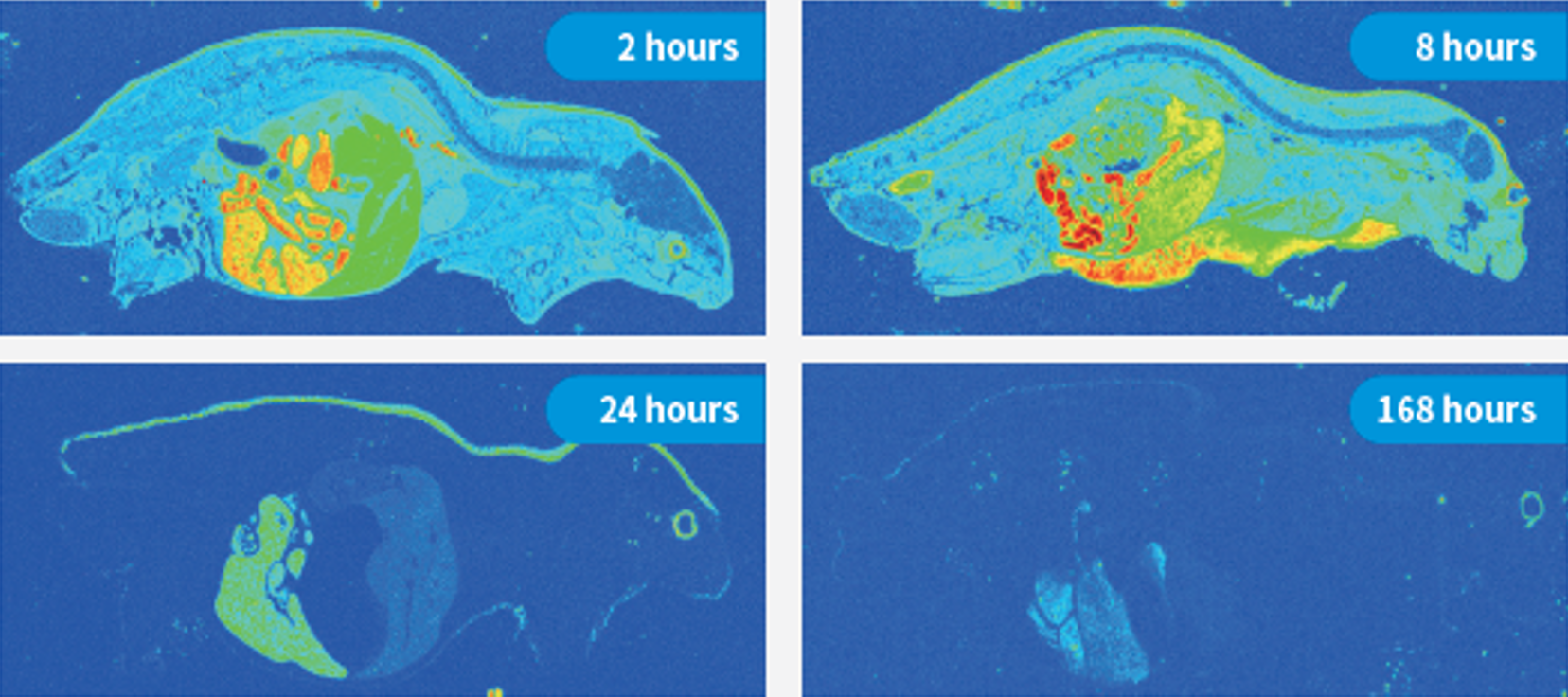Radiolabeled In Vivo PK/ADME Studies
Gain comprehensive insights into your drug candidate’s journey from lead optimization to preclinical testing and IND submission with WuXi AppTec. Radiolabeled in vivo PK/ADME studies provide invaluable data on drug bioavailability, tissue distribution, metabolism, and elimination kinetics within living organisms – empowering informed decision-making in drug development and accelerating the journey from bench to patient.
IND-Enabling Packages
In Vivo Studies
Custom Radiolabeled
In Vivo PK/ADME Assays
Radiolabeled ADME assays provide insight into a drug candidate’s journey in the body, allowing researchers to evaluate the compound’s behavior and routes. With your own test article or radiolabeled test articles synthesized directly at WuXi AppTec, we provide custom radiolabeled in vitro and in vivo preclinical and clinical analysis studies with a proven track record, ensuring compliance and successful submissions.
- Comprehensive Radiolabeling Expertise: Leverage our in-house synthesis of 14C- and 3H-radiolabeled test articles, ensuring cost-effective, timely production, and seamless incorporation into your studies.
- Customized Study Designs: Develop personalized study protocols that integrate both non-labeled and radiolabeled assays, tailored to the specific characteristics of your test article.
- Regulatory Compliant Data: Generate high-quality 14C- and 3H-radiolabeled data to support preclinical and clinical studies for regulatory submissions.
- Rapid Turnaround: Benefit from our efficient processes that deliver timely results, keeping your project on schedule and enabling faster decision-making.
Preclinical radiolabeled in vivo PK/ADME testing
Preclinical radiolabeled in vivo PK/ADME testing plays a vital role in characterizing a drug candidate’s behavior in the body, offering essential data on its safety, efficacy, and likelihood of success in clinical trials. By incorporating radiolabeled compounds, researchers can precisely trace the movement and transformation of the drug and its metabolites, gaining valuable insights into its pharmacokinetic and metabolic profiles. This testing assesses the recovery rate and mass balance of total radioactivity in excretory outputs like urine and feces, investigates tissue distribution to understand how the drug is dispersed throughout the body, establishes concentration-time profiles in plasma and blood, and identifies and profiles metabolites in plasma, bile, urine, and feces to elucidate metabolic pathways. We are equipped with advanced imaging techniques and state-of-the-art laboratory equipment, including Cryo-Imaging and Quantitative Autoradiography (CIQA), 2D and 3D image analysis, Leica®/Vibratome microtomes, and GE Typhoon™ image scanners, PerkinElmer® oxidizers, liquid scintillation counters (TopCount® and beta-counters), and the DEBRA™ Laboratory Information Management System (LIMS).
Quantitative Whole-Body Autoradiography (QWBA)
Representative Quantitative Whole-body Autoradiography images at Various Time Points following Oral Administration of [14C] Test ARticle to Male LE Rats

Clinical In Vivo PK/ADME
To conduct a single-center, single-dose, open-label mass balance clinical trial using radiolabeling technology, the human [14C]-AME study monitors the in vivo absorption, metabolism, and excretion processes following administration of a 14C test article formulation. The main research objectives include:
- Determining the mass balance results and identifying the primary excretion routes of the radiolabeled test article in humans.
- Analyzing the whole blood to plasma ratio and the pharmacokinetics of total radioactivity in plasma.
- Identifying the major metabolites present in urine, feces, and plasma.
We work with established clinical centers in the U.S. and China, as well as client-designated clinical trials units, to conduct evaluations of radiolabeled drugs in humans.

Explore PK/ADME Insights
Frequently Asked Questions
What are radiolabeled in vivo PK/ADME studies?
Why are radiolabeled in vivo PK/ADME studies important in drug development?
Radiolabeled in vivo PK/ADME studies provide crucial pharmacological and toxicological information that guides decision-making in drug discovery and development, ultimately enhancing the efficiency and success of the drug development process.
How are radiolabeled test articles administered in in vivo studies?
Radiolabeled test articles are administered in in vivo studies through various routes, including oral, intravenous, subcutaneous, intramuscular, intraperitoneal, dermal, and inhalation. The choice of administration route depends on factors such as the properties of the test article, the intended clinical route, and the research objectives. Each route offers distinct advantages and is selected based on the study design and desired outcomes.
What are the benefits of using radiolabeled compounds in PK/ADME studies?
Radiolabeled compounds offer several benefits in preclinical PK/ADME studies, including sensitive detection, selective labeling for pathway analysis, real-time monitoring of drug behavior, and precise assessment of tissue distribution and bioavailability.
How do radiolabeled in vivo PK/ADME studies contribute to understanding drug metabolism?
Radiolabeled in vivo PK/ADME studies facilitate metabolic pathway analysis, predictive modeling for human pharmacokinetics, and safety evaluation, enhancing the understanding and optimization of drug candidates before clinical trials.
What regulatory considerations are involved in conducting radiolabeled in vivo PK/ADME studies?
In conducting radiolabeled in vivo PK/ADME studies, regulatory considerations include compliance with radiation safety protocols, adherence to animal welfare regulations, and potential requirements for Good Laboratory Practice (GLP) standards.
How do researchers analyze data from radiolabeled in vivo PK/ADME studies?
Data analysis from radiolabeled in vivo PK/ADME studies involves a combination of quantitative measurements, chromatographic techniques, mass spectrometry, mathematical modeling, statistical analysis, and data integration to derive meaningful insights into drug pharmacokinetics and ADME properties.
What are the challenges associated with radiolabeled in vivo PK/ADME studies?
Some challenges of radiolabeled in vivo PK/ADME studies include: radiolabeling without altering drug properties, selecting appropriate radioisotopes, ensuring safety in handling radioactive materials, and detecting radiolabeled compounds with high sensitivity.
What types of drugs or compounds can be studied using radiolabeling?
Radiolabeling can be applied to small molecules, biologics, nanoparticles, radiopharmaceuticals, metabolites, and prodrugs for studying their pharmacokinetics, biodistribution, metabolism, and target engagement in vivo.
How do radiolabeled in vivo PK/ADME studies differ from other pharmacokinetic and ADME studies?
Radiolabeled in vivo PK/ADME studies use radioisotopes to track drug behavior in living organisms with high sensitivity and precision, enabling detailed quantification and metabolite tracking.
How do radiolabeled in vivo PK/ADME studies contribute to drug candidate selection and optimization?
Radiolabeled in vivo PK/ADME studies significantly contribute to drug candidate selection and optimization by providing insights into pharmacokinetic profiles, metabolic pathways, tissue distribution, and target engagement. They help prioritize candidates with favorable ADME properties, optimize dosing regimens and formulations, identify metabolic liabilities early, and support regulatory submissions with comprehensive data on safety and efficacy.
Need Radiolabeled in vivo
PK/ADME Testing?
Talk to an expert today about your radiolabeled testing needs.



